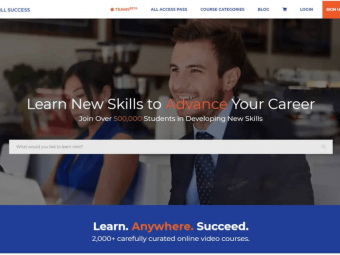Accounting In 60 Minutes A Brief Introduction
Tags: Accounting
Learn the very basics of accounting in just about an hour.
Last updated 2022-01-10 | 4.5
- Understand the basic accounting equation- Know the difference between a debit and a credit
- See how to prepare a balance sheet and income statement
What you'll learn
* Requirements
* No prerequisite knowledge is required!Description
National Association of State Boards of Accountancy (NASBA)
NASBA CPE credits: 2.0
Recommended NASBA field of study: Accounting
Program level: Basic
To earn NASBA CPE credits:
- Complete all videos
- Score 70% or higher on final exam
Glossary: Find PDF attached to the first lecture of this course.
Completion to obtain CPE should be accomplished a year after purchase date.
If you undertake this course for NASBA CPE credits, please complete the Self Study Course Evaluation.
Udemy is registered with the National Association of State Boards of Accountancy (NASBA) as a sponsor of continuing professional education on the National Registry of CPE Sponsors. State boards of accountancy have the final authority on the acceptance of individual courses for CPE credit. Complaints regarding registered sponsors may be submitted to the National Registry of CPE Sponsors through its website: www.nasbaregistry.org. For additional information including refunds and complaints, please see Udemy Terms of Use. For more information regarding administrative policies, please contact our support.
Course content
8 sections • 23 lectures
What = Who Preview 04:04
The accounting equation is the basis of accounting. However, the formal equation can be confusing. In this lecture you will learn the simplified equation (What=Who) and how it is the foundation of the accounting profession. By the end of the lecture you will understand the more formal accounting equation.
Let's Buy a Car Preview 03:33
The best way to learn the accounting equation is to look at an example that we are all familiar with. In this lecture we will buy a car. We will look at this purchase from two views: what are our assets and who has claim to them. Please excuse my car drawing skills! By the end of the lecture you will have a clearer understanding of the accounting equation.
Some Practice Entries Preview 03:24
This lecture will begin to use specific accounts. Accounts summarize similar activities. You will begin to see which accounts are assets, which are liabilities and which are equity.
CPE Review Quiz: Section 1
Let's review what you've learned in Section 1.
Debits = Credits Preview 07:19
Debits and credits give accounting students fits. In this lecture you will get a clear understanding of what is a debit and what is a credit. You will know by the end of the lecture when to debit and when to credit. You will find that this is a painless activity!
The Trial Balance Preview 05:55
A trial balance is just that: we try to balance. In this lecture we will set up a trial balance and see why it is an important tool for accountants. And you will understand why it can save us a lot of time before we prepare our financial statements.
Debit and Credit Worksheet - A One Page Template to Help You Know When To Debit! Preview 1 page
I've developed a one page scratch sheet that you can use when entering debits and credits. You will see that the T-account is shaded on the side that reflects its normal balance. Print these out and keep them near by!
CPE Review Quiz: Section 2
Let's review what you've learned in Section 2.
It Balances! Preview 06:00
In this lecture we prepare our first financial statement! It is the Balance Sheet. You might have seen balance sheets before. You will see how they are prepared and what they mean. Your knowledge from the previous lectures will give you the skill to understand the details on this statement.
CPE Review Quiz: Setion 3
Let's review what you've learned in Section 3.
Income Accounts Preview 07:06
In the very early days of accounting, business managers did not have an easy mechanism for keeping track of income and expenses. In this lecture you will see why we developed income and expense accounts. You will understand their impact on equity. You will see how they are related to the balance sheet.
Net Income Preview 04:07
In this lecture you will learn the connection between net income and the balance sheet. By the end of the lecture you will see how income (and expense) affects the balance sheet.
The Income Statement Preview 04:28
The income statement! In this lecture you will see how it is prepared and how it contrasts the balance sheet. This is a major financial statement and by the end of the lecture you will understand it's use.
CPE Review Quiz: Section 4
Let's review what you've learned in Section 4.
A Short Ebook on How to Put Together a Balance Sheet Preview 9 pages
Here is a valuable extra! I've placed this short ebook for you that will reinforce much of the information that we have covered so far! I even did the artwork myself!
CPE Review Quiz: Section 5
Let's review what you've learned in Section 5.
It's All About Timing Preview 04:16
Many business owners and managers believe that profit equals cash. That mistaken belief can jeopardize their businesses. In this lecture you will see why profit does not equal cash. You will also understand when we recognize income and when we recognize expenses.
Income Does Not Equal Cash Preview 04:54
This lecture will show you that cash can come in before we recognize income, when we recognize income or after we recognize income. By understanding this, you will see that cash flow does not follow income. This knowledge is not only valuable as a student of accounting but it can also save your business!
Expenses and Timing Preview 03:25
This lecture will explain why cash can go out of our business before we make an expense, when we make an expense or after we make an expense. Again you will gain insights to why profit does not equal cash. This information along with what you learned in the previous lecture will demonstrate how important it is for a business to manage cash flow.
CPE Review Quiz: Section 6
Let's review what you've learned in Section 6
What We Have Learned Preview 02:08
It's wrap up time! In just few lessons you have learned some very important basic accounting concepts! We will review the major points. This was a fun adventure! You have acquired valuable information that can help you in business. And you have a good introduction that can help you pursue accounting coursework.
How To Increase Your Profits with Break Even Analysis! Preview 30 pages
A cupcakes store recently opened in our town. It was located in the new section of the city. The owner did not spare any expense in setting up the store. But alas. Twelve months later the store closed and the owner's dreams were vanquished.
I thought to myself: "They didn't figre out how many cupcakes to sell to pay the rent!"
Every day entrepreneurs launch their dream and look forward to the day when their operation is a thriving business. However, they don't calculate how many cupcakes do they have to sell to pay the rent!
What is takes to break even is the single most important number in your enterprise. Without it, you do not have a targe to reach for.
This ebook "Who To Increase Your Profits with Break Even Analysis" will show you not only how to compute your break even point, but it will give you four strategies to increase your profits.
Whether you have been in business for some time or if you are just thinking about starting a business, this fun to read booklet provides you the tools to formulate a profitable strategy!
It is my gift to you! Enjoy! I hope that it makes for ever expanding profits!
CPE Qualified Assessment
In order to receive CPE credit for this course, you must a) complete all course content, and b) pass this qualified assessment with 70% or greater.








 This course includes:
This course includes:
![Flutter & Dart - The Complete Guide [2022 Edition]](https://img-c.udemycdn.com/course/100x100/1708340_7108_5.jpg)















